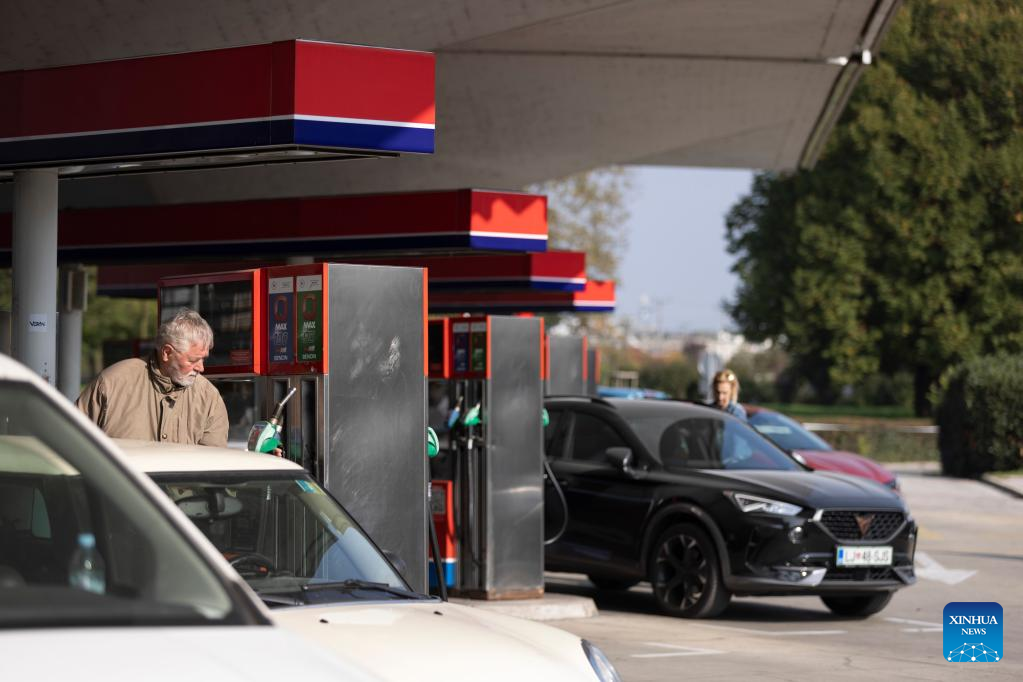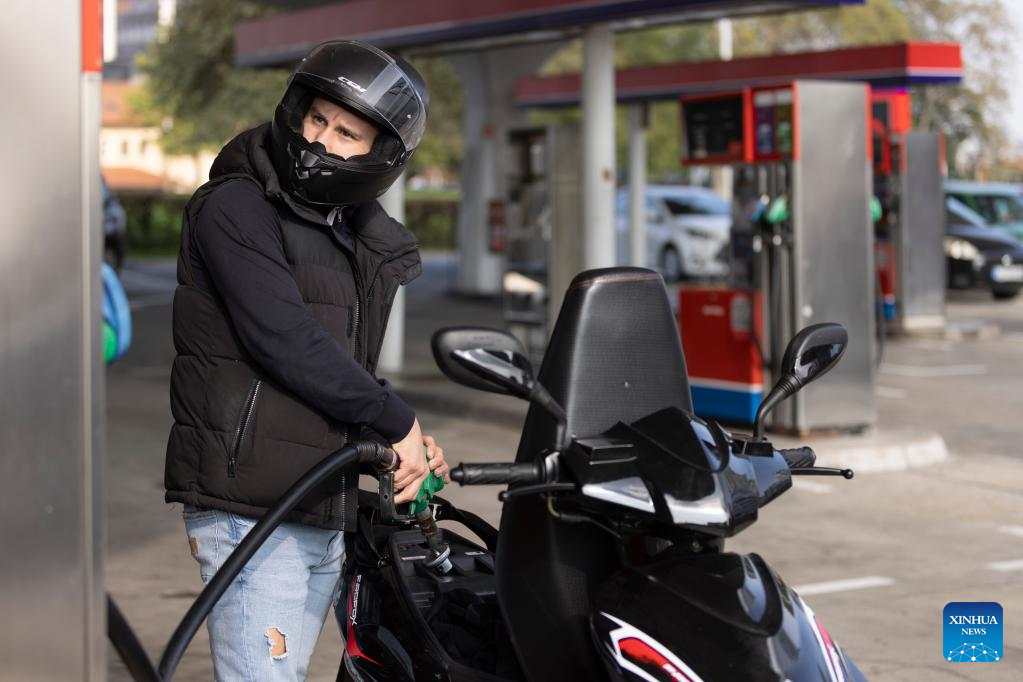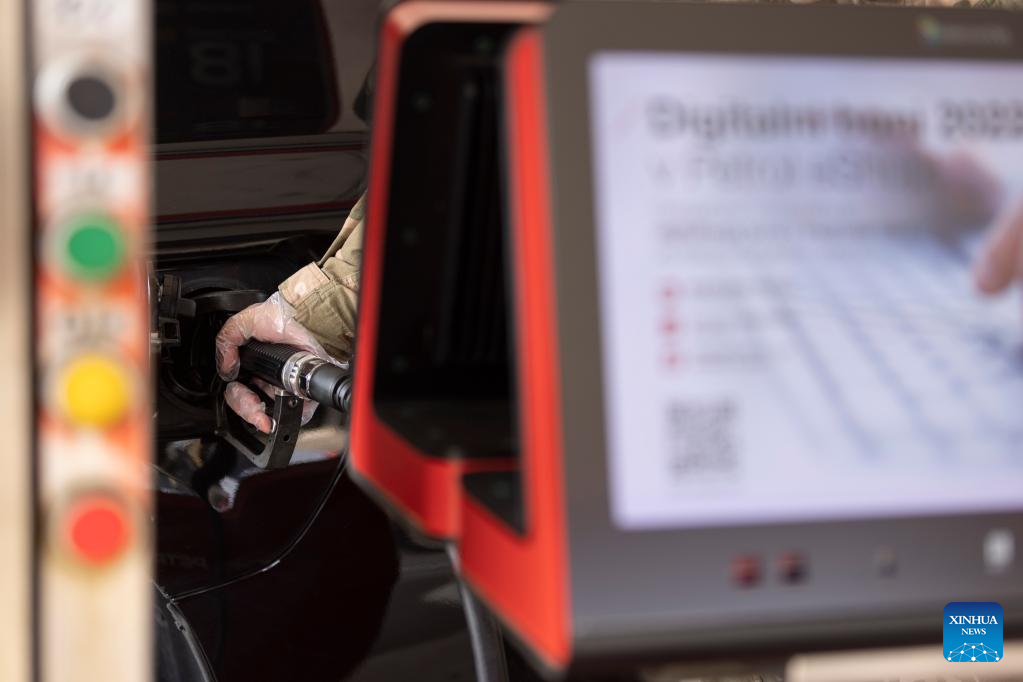
This photo taken on Oct. 14, 2022 shows a view of a petrol station in Ljubljana, Slovenia. (Photo by Zeljko Stevanic/Xinhua)
LJUBLJANA, Nov. 7 (Xinhua) -- The ongoing energy crisis and the conflict in Ukraine that continues unabated have turned life upside down for millions in Europe -- Slovenians included.
The onset of winter is only adding to worries for this country's 2.1 million population, who have already been hit hard by the cost-of-living crisis, the surging inflation and the staggering rises in energy bills. While the government appears to go out of its way to ensure adequate and affordable supplies, environmentalists warn of a pending ecological crisis.
"I live on a shoestring," Ales Bavdek, a vegetable grower who runs a stall at a market in central Ljubljana, told Xinhua in a recent interview.
"Inflation has affected us so badly that we cannot afford much. Nowadays we spend too much on energy and saving money is out of the question."
According to the national statistical office, Slovenia's annual inflation rate stood at 10 percent in September, compared to 11 percent in August, the highest level in the country in nearly 20 years.
Soaring prices for fuel, electricity and food were the main drivers of inflation.
Peter Macinkovic, a native of Ljubljana, said that he, too, felt the pinch from the rising prices.
"I'm trying to save on heating, on food and on everything," he said. "As a result, the quality of my life is not the same as before. But, for now, we need to tighten our belts and live with it."
The average heating cost per household already jumped 40 percent last winter in Slovenia, though the annual inflation rate was only 1.9 percent in 2021.
With the soaring energy and food prices this year, it will be really difficult for low-income people to make ends meet, commented Nastja Korencav, a native of Kranj, Slovenia's third largest city.
"Those who earn just 700 or 800 euros a month will have a hard time. I worry about the children and the elderly in low-income families," she said.
When it rains it pours
The energy crisis has also dealt a severe blow to Slovenia's energy-intensive enterprises.
On Oct. 1, aluminium smelter Talum had to cut its production of primary aluminium for the third time in less than a year. The company has so far reduced output by 1.3 million tonnes, even though global demand for aluminium has been increasing by 5 to 7 percent annually and the company's competitors outside Europe are ramping up production.
Steel group SIJ, one of Slovenia's largest exporters, cut production by a third in September due to the exceptionally high energy prices and citing uncertainty as to whether buyers would accept higher prices. A further 40 percent output cut is planned for the final quarter of this year.
Slovenia's car, glass and paper industries, as well as the country's ski resorts, are also considering closures during peak electricity consumption periods.
A recent survey conducted by the Chamber of Craft and Small Business (OZS) showed that more than half of its member businesses expected their electricity and gas bills to increase by at least 50 percent year-on-year. About 20 percent reported drastic -- 100 to 500 percent -- increases.
Three-quarters of the 820 OZS member businesses surveyed expected the high energy costs to dent their profits, and 32 percent said their business was under direct threat. A third of the respondents said they would have to scale down operations and 15 percent were considering laying off workers.
The government has moved to ease the energy crisis by regulating and capping gas prices, launching aid packages and reducing value-added tax (VAT) on energy products.
The country has signed agreements on solidarity gas deliveries with its neighbouring countries to protect households, healthcare and educational institutions, as well as social service providers in case of gas supply disruptions.
Meanwhile, Slovenia is also exploring foreign energy resources, including gas from Algeria and coal from Indonesia.
Jernej Salecl, director general of the Directorate for Internationalization, Entrepreneurship and Technology in the Ministry of Economic Development and Technology, believes that the measures taken by the government are working, although he acknowledges that these are only short-term solutions.
Longer-term solutions to the energy crisis, he said, would include setting prices and consolidating resources on the European Union (EU) level, being more rational in energy consumption and seeking alternative energy sources to reduce dependence on natural gas.
Temperatures in Slovenia tend to drop below freezing in December and January. For now, the country's natural gas reserves are still below the EU's storage target of 80 percent by Nov. 1. Several small and medium-sized natural gas companies have even stopped, or plan to stop, supplies.
The country's only lignite mine in operation in Velenje has only two weeks' worth of coal stock.
In response to the government's request to expand production and build up reserves, Janez Roser, chief executive officer (CEO) of mine operator Premogovnik Velenje, said that production is restrained by a lack of mine workers and the limited mining area -- and it would take at least three years to expand the latter.
The ripple effect of the energy shortages is immediate: Slovenia relies on imports for 75 percent of its electricity following the recent shutdown of a thermal power plant to save coal for the winter. Meanwhile, its nuclear power plant at Krsko is undergoing maintenance.
Proposals for building new hydropower and nuclear power plants, and for restarting the country's thermal power plants, have triggered outcries from environmentalists.
"We are against nuclear energy," Vojko Bernard, president of the international environmental organisation Alpe Adria Green, said. "Restarting a nuclear power plant poses additional risks because there is a bigger chance of malfunction."
Instead of building another nuclear power plant, Bernard said Slovenia should make better use of its geothermal and solar energy resources. ■

A man fills a motorbike at a petrol station in Ljubljana, Slovenia, Oct. 14, 2022. (Photo by Zeljko Stevanic/Xinhua)

This photo taken on Oct. 14, 2022 shows a view of a petrol station in Ljubljana, Slovenia. (Photo by Zeljko Stevanic/Xinhua)

A person fuels a vehicle at a petrol station in Ljubljana, Slovenia, Oct. 14, 2022. (Photo by Zeljko Stevanic/Xinhua)



